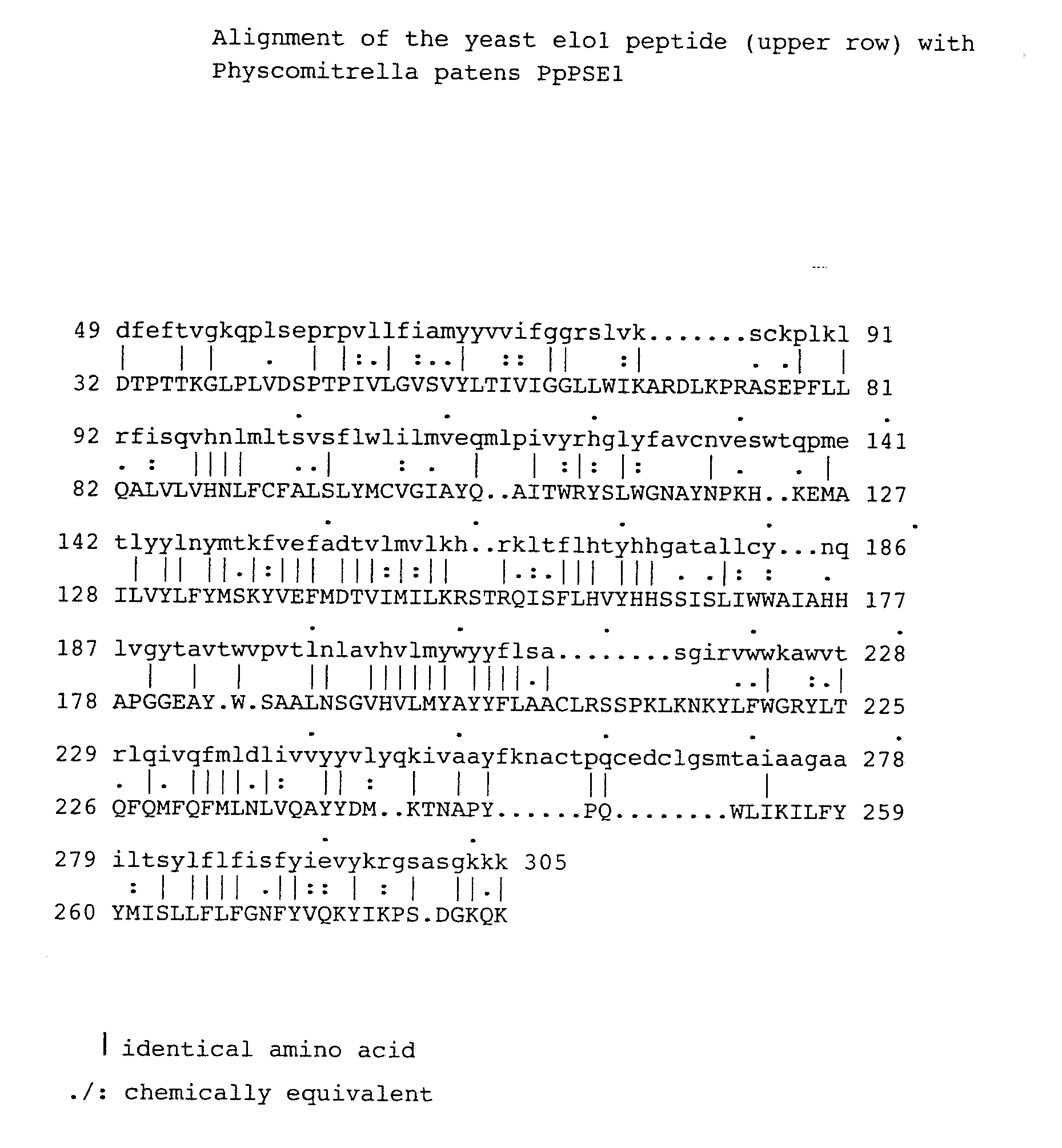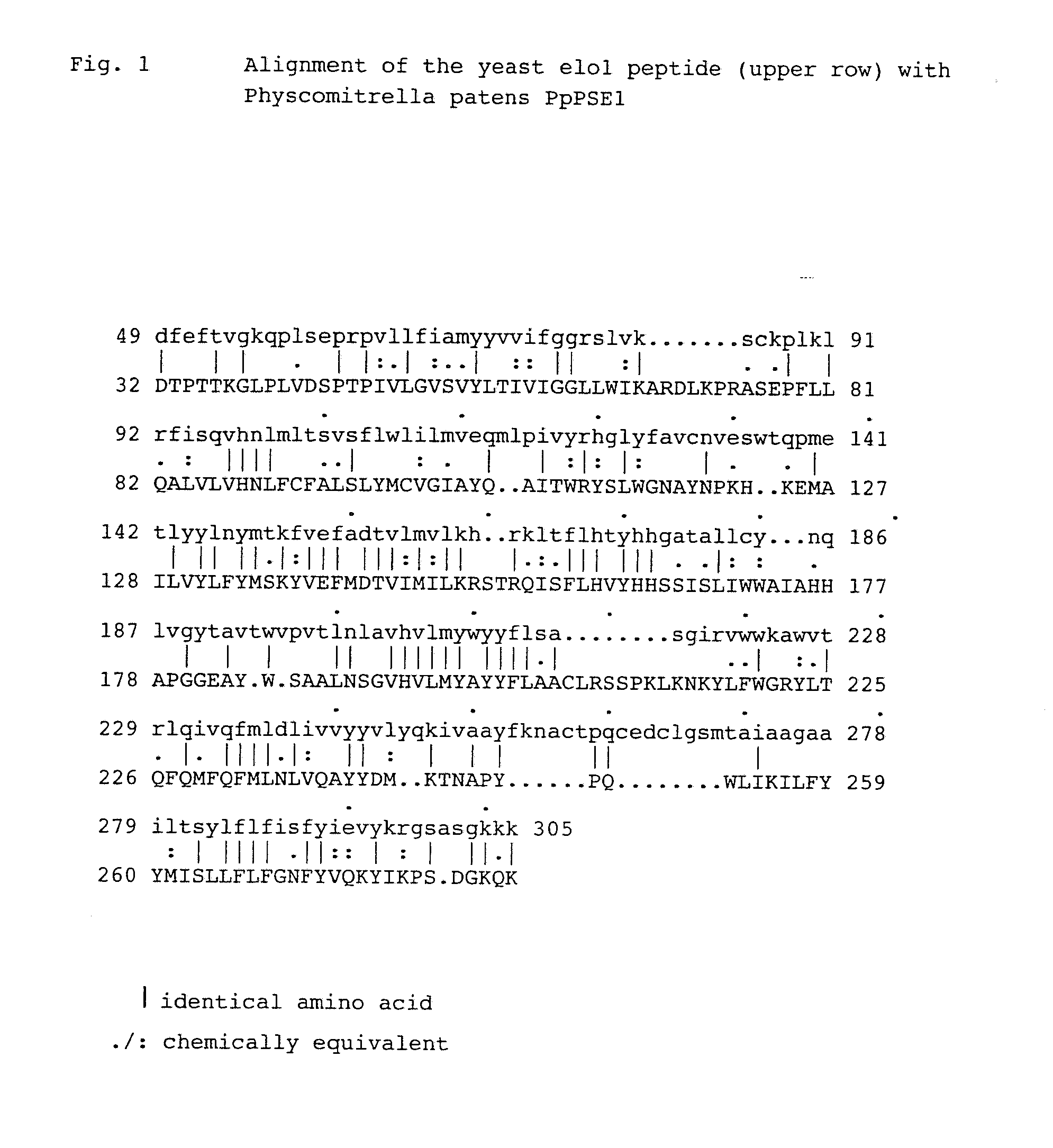Novel elongase gene, and process for the preparation of polyunsaturated fatty acids
a polyunsaturated fatty acid and gene technology, applied in the field of new elongase gene, can solve the problems of fatty acid, specific unsaturated fatty acid, time-consuming and difficult procedures,
- Summary
- Abstract
- Description
- Claims
- Application Information
AI Technical Summary
Benefits of technology
Problems solved by technology
Method used
Image
Examples
example 1
General Methods
a) General Cloning Methods:
[0177]Cloning methods, such as, for example, restriction cleavages, agarose gel electrophoresis, purification of DNA fragments, transfer of nucleic acids to nitrocellulose and nylon membranes, linkage of DNA fragments, transformation of Escherichia coli and yeast cells, the culture of bacteria and the sequence analysis of recombinant DNA were carried out as described in Sambrook et al. [(1989), Cold Spring Harbor Laboratory Press: ISBN 0-87969-309-6] or Kaiser, Michaelis and Mitchell [(1994), “Methods in Yeast Genetics”, Cold Spring Harbor Laboratory Press: ISBN 0-87969-451-3]. The transformation and culture of algae such as Chlorella or Phaeodactylum are carried out as described by El-Sheekh [(1999), Biologia Plantarum 42:209-216] or Apt et al. [(1996) Molecular and General Genetics 252 (5):872-9].
b) Chemicals
[0178]Unless otherwise specified in the text, the chemicals used were obtained in analytical grade quality from Fluka (Neu-Ulm), Merc...
example 2
Isolation of Total DNA from Plants and Microorganisms such as Thraustochytrium and Crypthecodinium for hybridization experiments
[0185]The details on the isolation of total DNA refer to the work-up of plant material with a fresh weight of one gram.
CTAB buffer: 2% (w / v) N-acetyl-N,N,N-trimethylammonium bromide (CTAB); 100 mM Tris-HCL, pH 8.0; 1.4 M NaCl; 20 mM EDTA.
N-Laurylsarcosine buffer: 10% (w / v) N-laurylsarcosine; 100 mM Tris-HCl, pH 8.0; 20 mM EDTA.
[0186]The plant material or Crypthecodinium or Thraustochytrium cell material was triturated under liquid nitrogen in a mortar to give a fine powder and transferred into 2 ml Eppendorf vessels. The frozen plant material was then covered with a layer of 1 ml of decomposition buffer (1 ml CTAB buffer, 100 ml N-laurylsarcosine buffer, 20 ml β-mercaptoethanol and 10 ml proteinase K solution, 10 mg / ml) and incubated at 60° C. for one hour with continuous shaking. The homogenate obtained was distributed into two Eppendorf vessels (2 ml) and...
example 3
Isolation of Total RNA and Poly(A)+-RNA from Plants and Microorganisms (Crypthecodinium and Thraustochytrium)
[0187]Total RNA was isolated from plants such as linseed and oilseed rape by a method described by Logemann et al (1987, Anal. Biochem. 163, 21). The total RNA from moss can be obtained from protonema tissue using the GTC method (Reski et al., 1994, Mol. Gen. Genet., 244:352-359).
RNA Isolation from Crypthecodinium and Thraustochytrium:
[0188]Frozen samples of algae (−70° C.) are triturated in an ice-cold mortar under liquid nitrogen to give a fine powder. 2 volumes of homogenization medium (12.024 g sorbitol, 40.0 ml 1M Tris-HCl, pH 9 (0.2 M); 12.0 ml 5 M NaCl (0.3 M), 8.0 ml 250 mM EDTA, 761.0 mg EGTA, 40.0 ml 10% SDS are made up to 200 ml with H2O and the pH is brought to 8.5) and 4 volumes of phenol with 0.2% mercaptoethanol are added to the frozen cell powder at 40-50° C. while mixing thoroughly. Then, 2 volumes of chloroform are added and the mixture is stirred vigorousl...
PUM
| Property | Measurement | Unit |
|---|---|---|
| pH | aaaaa | aaaaa |
| temperature | aaaaa | aaaaa |
| temperature | aaaaa | aaaaa |
Abstract
Description
Claims
Application Information
 Login to View More
Login to View More - R&D
- Intellectual Property
- Life Sciences
- Materials
- Tech Scout
- Unparalleled Data Quality
- Higher Quality Content
- 60% Fewer Hallucinations
Browse by: Latest US Patents, China's latest patents, Technical Efficacy Thesaurus, Application Domain, Technology Topic, Popular Technical Reports.
© 2025 PatSnap. All rights reserved.Legal|Privacy policy|Modern Slavery Act Transparency Statement|Sitemap|About US| Contact US: help@patsnap.com



